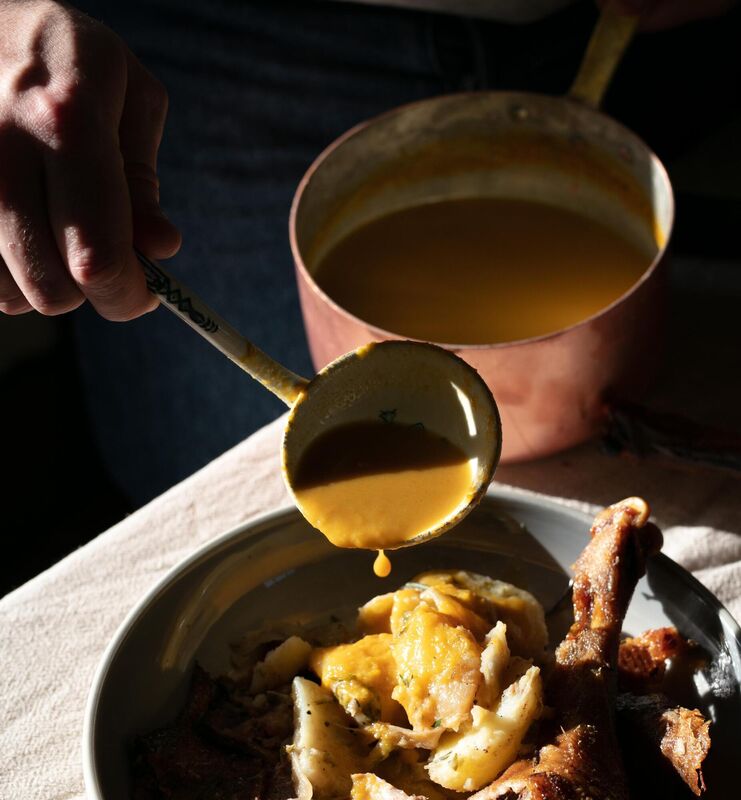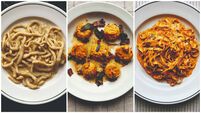Forget the turkey, here's how to make Christmas goose with stuffing and gravy

A delicious Christmas goose. Photo: Bríd O'Donovan.
It was forever being said that 'next year will be the year we will ditch the turkey and cook a goose for Christmas'. Although my mother was particularly good at bringing out the best in turkey, we always felt that the grass would be greener if we ever got round to ordering a goose early enough to beat the demand for the only 12,000 or so sold in Ireland each year.
The farming of geese in Ireland goes back to ancient times and the ones we now eat are all descended from the greylag goose of Northern Europe. Brehon laws held them in higher regard than sheep, with two birds getting the same amount of grazing land as one sheep.
They have long had a reputation as brilliant guard dogs, with their aggressive territorial nature. Many people are startled when they see domesticated geese for the first time due to their huge size. They are at their fattest just after harvest and are therefore a traditional choice for the Christmas table.
The idea of a Christmas goose goes back to the very origins of the holiday and farther back still from medieval Michaelmas to the Vikings and ancient Greece. Turkey replaced geese in the Americas, being natives of those lands and so became commonplace here in Europe too. Turkeys have a lot more eating in them but nothing compares to the goose for its robust succulence which touches on being almost beefy. Geese, after all, graze on grass, just like cattle.
Because of the small-scale, seasonal nature of farming geese in Ireland, almost all of them would be very much free-range and more often organic. We did manage to book one this year, at last. Geese are perfect for smaller families who struggle to eat enough post Christmas sandwiches to use up the mountains of turkey meat.
The only real eating in a goose is its breast which is deeply delicious and although they are large, they probably won’t last beyond the main event and a sandwich the next day.
We have ordered an organic one from Skeaghanore farm in West Cork. Other great producers are Maperath farm in Meath; Salters farm in Carlow; and Pheasants hill in Down. A good butcher will usually have geese to order at Christmas. I ordered the ones in the photos here from FxBuckley in Deansgrange and it was absolutely massive and utterly delicious. Try to get your orders in as early as possible as demand is always quite high.
This was my first time cooking a goose and it was a lot more straightforward than I was expecting. When I picked up the goose, I have to say I was quite intimidated by the sheer size of it. The butcher in FXBuckley gave me the one that they had hanging in the window and it was a beauty. Geese are left hang for a number of days before being sold to give the meat more flavour.
I asked everyone I could think of (including the butcher) for advice and compiled this method which worked perfectly for me. The main things to watch out for are the copious and frankly startling amount of fat that comes off the goose and also how quickly the skin will brown. To combat these, it is best to have the goose on a rack above the baking tray and also be prepared to cover the goose in foil, should it start to brown too fast.
- Free-range goose, oven ready (roughly 5kg)
- Salt & Pepper
- Butter
- 1 lemon
- Preheat the oven 220°C.
- Leave the bird out of the fridge, on your kitchen counter while you prepare everything else.
- Pierce the lemon all over and shove it into the carcass along with the stuffing. Rub the goose with sea salt, black pepper and then lightly cover in soft butter. Some people advised me to pierce the skin and others told me not to bother. I decided not to and it didn’t seem to have any negative effects.
- Place the goose on the wire rack above a very large baking tray which is deep enough to handle a flood of fat. Do not underestimate just how much fat will start to drip off the bird almost immediately after you place it in the oven. The fat melts at a much lower temperature than most meats.
- Leave the goose in the oven for 20 minutes at 220°C and then lower the temperature to 180°C. You can remove the fat from the tray underneath as the goose cooks if you like. Be very careful if you do this — a turkey baster would be the safest way. The skin should reach a brown walnut colour but no darker: be prepared to cover the bird in foil towards the end of the cooking.
- When the goose is ready, very carefully lift the goose from the rack and place on a large board. Cover with foil.
- Very carefully remove the fat, passing it through a very fine sieve or cheesecloth into a jug or large jar and leave to cool before transferring to the fridge.
- Carve using a long sharp carving knife and fork. Start as close to the breastbone as possible and move the knife between the breast meat and the ribcage until the whole thing comes away. Repeat on the otherside. Carve this breast meat into short, thick slices. You can cut slices from the legs, but it won’t give you much meat.
This is the first thing you should start to get ready before everything else. A good stuffing is essential for any Christmas bird and the goose is no different. For turkey I usually would make a sausage and breadcrumb type stuffing with lots of thyme. For a goose, which tastes completely different, I decided to make one made with potatoes, apples and lemons. The apple in particular works so well with the goose meat and the potatoes soak up lots of that goose fat in the carcass making them wickedly delicious. This is about as simple as a stuffing could be.

Ingredients:
- 1.5kg potatoes, peeled and quartered
- 400g, medium onions or shallots, peeled and sliced thickly
- 2 lemons
- 5 eating apples, peeled, cored and cut into thick chunks
- Few sprigs of rosemary, needles chopped
- 8-10 sprigs of thyme
- Olive oil
- Sea salt and black pepper
- In a shallow pan over a medium-high heat, add the oil along with the onion, cooking them until soft and golden. Season lightly.
- Boil the potatoes in salted water for about 10 minutes until they have just started to soften.
- In a bowl, combine the part-boiled potatoes, softened onions, apple, rosemary, thyme, and olive oil. Squeeze the juice of the two lemons over this. Season liberally with sea salt and freshly-cracked black pepper.
This simple stuffing should fill the carcass. You can put some in the neck end as well.
This gravy is pretty traditional but utterly perfect for goose. Get a few chicken wings from your local butcher. Supermarkets usually won’t have chicken wings that are not covered in some sort of barbecue sauce. If your goose comes with the giblets you can use these as well, but be careful not to include the liver. This can be made the day before and reheated on the day. I like my gravy on the thin side as this was always how my mother made it. Like liquid gold, it soaks into the breast meat, plumping up each bite with even more flavour. I find thicker gravy too claggy with goose.

- 6 chicken wings
- goose giblets minus liver (optional)
- 3 cloves of garlic
- 1 medium onion, peeled and halved
- 2 large carrots, peeled
- 2 sticks of celery
- 8 peppercorns
- Large pinch of sea salt
- 3 bay leaves
- 1.5litres of water
- 2 large shallots, finely diced
- butter
- 50ml sherry, Marsala or Madeira
- First make the stock by boiling together the water, chicken wings; giblets; one of the carrots, roughly chopped; one stick of celery, roughly chopped; the halved onion; garlic cloves; peppercorns; bay leaves; and sea salt.
- Lower the heat and simmer for around one hour. Pass through a fine sieve into a large jug and discard the solids.
- In a medium-large pot, add a little butter and the shallot and soften over a medium-high heat. Add the other carrot, finely diced, and the other celery stick, finely diced.
- Once all the vegetables have softened, add the sherry and let bubble away for a few minutes before adding back the hot stock.
- Bring to the boil again and then lower the heat, simmering for another 30 minutes. The gravy should be fairly thin and packed full of flavour. Check the seasoning but it should be good. Heat up gently just before serving.





